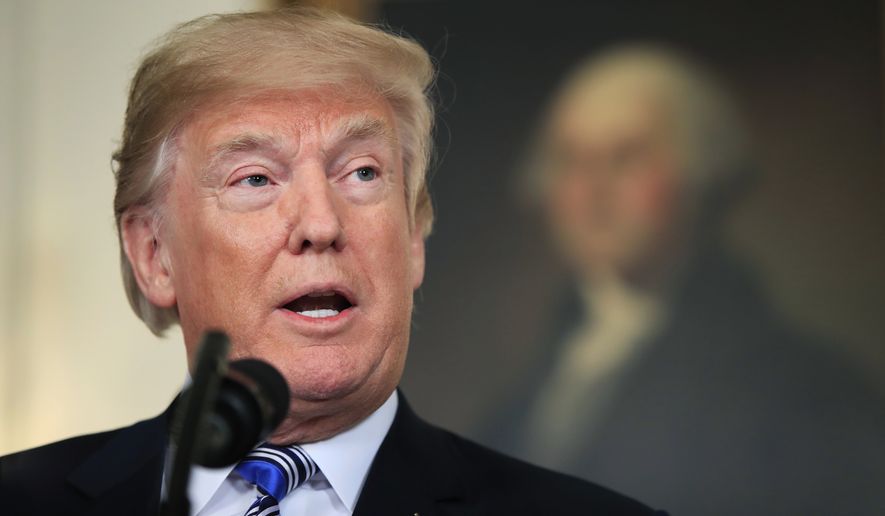This isn’t a U.S.-China trade war yet, but economist are calling it the weigh-in before the big fight.
Beijing taunted President Trump on Wednesday by releasing a $50 billion list of U.S. products it has targeted with tariffs, responding in kind to the Trump administration’s threat to increase taxes on 1,300 of China’s high-tech imports also worth about $50 billion.
It was the second tit-for-tat exchange of tariff threats this week between the world’s two largest economies, and it sent the stock market into wild swings based on investors’ fears of a trade war.
“This is not a trade war yet. It’s more like probing actions prior to a battle, with both sides gauging how far they can push the other without full-blown action,” said George Washington University economist Michael Moore. “But this is certainly how they might start.”
The 106 products on China’s new tariffs list hit the U.S. and Mr. Trump where it hurts — in agriculture and other industries that do big business in China and dominate regions of the country that make up the president’s political base.
Beijing proposed a 25 percent tariff on 106 products including soybeans, pork, cranberries, whiskey, automobiles, airplanes and plastic.
For Mr. Trump, the tariffs and other get-tough trade policies made good on a top campaign promise to crack down on China’s trade abuses. The tariffs and other moves targeting technology were aimed at China’s theft of American intellectual property, which has vexed U.S. companies for decades.
The president didn’t flinch.
“We are not in a trade war with China, that war was lost many years ago by the foolish, or incompetent, people who represented the U.S. Now we have a Trade Deficit of $500 Billion a year, with Intellectual Property Theft of another $300 Billion. We cannot let this continue!” Mr. Trump tweeted.
He added: “When you’re already $500 Billion DOWN, you can’t lose!”
That doesn’t mean there aren’t substantial risks from an escalating exchange of tariffs with America’s largest trading partner, such as higher prices paid by U.S. consumers and lost jobs for American workers in affected industries.
Denise Bode, a tax and trade analyst at a Washington law firm, said a full-blown trade war is possible but it is more likely that Mr. Trump will make a deal.
“It is more the beginning stages of a major reset in a trade relationship between China and the United States,” Ms. Bode said. “Obviously, it is a strong ploy, but a lot of our other efforts have not worked [and] everybody is at the table now.”
Meanwhile, the S&P 500 index and the Dow Jones industrial average erased early losses — the Dow fell as much as 501 points — and rallied to move higher Wednesday as investors hedged their bets on the likelihood of an all-out U.S.-China trade war.
The S&P 500 index added 14 points, or 0.5 percent, to 2,628 as of 2:30 p.m. Eastern time. The Dow climbed 86 points, or 0.4 percent, to 24,120. The Nasdaq composite rose 49 points, or 0.7 percent, to 6,990. The Russell 2000 index of smaller-company stocks gained 10 points, or 0.7 percent, to 1,522.
In issuing its hit list, Beijing blamed the U.S. for picking a fight.
“It must be said, we have been forced into taking this action,” said Wang Shouwen, China’s deputy commerce minister. “Our action is restrained.”
The value of the U.S. products was virtually identical to the $50 billion in Chinese high-tech products identified for tariffs on a list that the Trump administration rolled out late Tuesday.
Neither list will go into immediate effect. The U.S. tariffs require a monthslong comment and review process. China said it, too, is moving slowly.
Larry Kudlow, director of the president’s National Economic Council, tried to tamp down concerns about a trade war, saying a negotiated resolution is more likely.
“He wants to solve this with the least amount of pain,” Mr. Kudlow told reporters at the White House.
He also said Mr. Trump isn’t bluffing.
“I would take the president seriously on this tariffs issue,” Mr. Kudlow said. “There are carrots and sticks in life.”
The White House couldn’t allay all the fears.
Sen. Chuck Grassley, Iowa Republican, said he agreed with getting tough with China but Mr. Trump’s strategy puts his constituents in the crosshairs.
“Farmers and ranchers shouldn’t be expected to bear the brunt of retaliation for the entire country. It’s not fair, and it doesn’t make economic sense,” Mr. Grassley said. “The administration knew that if it imposed tariffs on Chinese goods, China would retaliate against U.S. agriculture. I warned President Trump as much in a White House meeting in February. Today shows that’s exactly what happened.”
Mr. Grassley said the federal government has a responsibility to mitigate damages caused by trade policies, and he vowed to push the issue in the Senate.
The 1,300 Chinese products on the U.S. tariff list included aerospace, pharmaceuticals and electronics.
Beijing had threatened to retaliate when Mr. Trump announced pending tariffs last month. China previously responded with a list of more than 120 U.S. items worth about $3 billion to hit with an import tax after the Trump administration imposed tariffs on steel and aluminum from all countries, though exemptions were later offered to Mexico, Canada, South Korea and other major importers of those metals.
⦁ This article is based in part on wire service reports.
• S.A. Miller can be reached at smiller@washingtontimes.com.




Please read our comment policy before commenting.